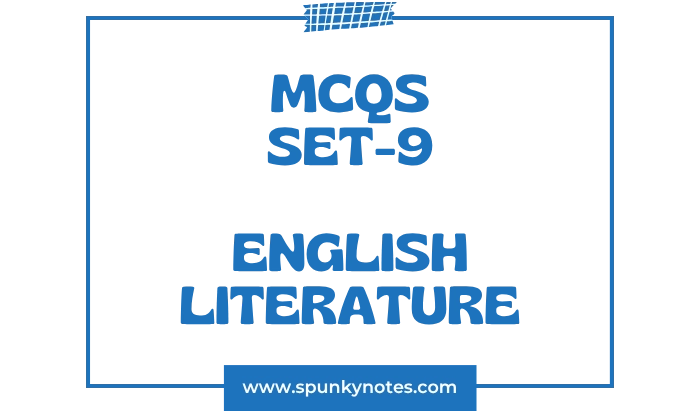

Estimated Reading Time: 17 min
English Literature MCQs
Set-9
1. Which of the arrangements of works in English Literature is in the correct chronological sequence?
A. Faerie Queene-Dr. Faustus-Canterberry Tales-Hamlet
B. Dr. Faustus-Canterbury Tales-Faerie Queene-Hamlet
C. Canterbury Tales-Dr. Faustus-Faerie Queene-Hamlet
D. Canterbury Tales-Faerie Queene-Dr. Faustus-Hamlet
2. Iago is a character in:
A. Macbeth
B. King Lear
C. Titus Andronicus
D. Shakespeare’s Othello
3. Who popularised the Comedy of Humours?
A. William Shakespeare
B. Thomas Dekker
C. Ben Jonson
D. Christopher Marlowe
4. The words “One may smile and smile and be a villain” occur in:
A. Macbeth
B. Othello
C. King Lear
D. Shakespeare’s Hamlet
5. Who is the author of Shakespearean Tragedy ?
A. T. S. Eliot
B. F. R. Leavis
C. Harold Bloom
D. A.C. Bradley
6. Bosola is a well-known character in a play by
A. Thomas Kyd
B. John Webster
C. Christopher Marlowe
D. Thomas Dekker
7. Which of the following sequences shows John Milton’s works in correct chronological order?
A. Lycidas – Arcades – Comus – Paradise Lost
B. Comus – Arcades – Lycidas – Paradise Lost
C. Arcades – Comus – Lycidas – Paradise Lost
D. Arcades – Paradise Lost – Comus – Lycidas
8. An Anatomy of the World is written by
A. George Herbert
B. Andrew Marvell
C. John Donne
D. Henry Vaughan
9. Which of the following works of Dryden deals with the story of Antony and Cleopatra?
A. The Indian Emperor
B. Aureng-Zebe
C. All For Love
D. Absalom and Achitophel
10. Robinson Crusoe was published in
A. 1709
B. 1711
C. 1719
D. 1729
11. Which of the following works is not by Jonathan Swift?
A. Gulliver’s Travels
B. A Tale of a Tub
C. The Battle of the Books
D. A New Voyage Round the World
12. Which of the following plays is not written by William Wycherley ?
A. The Country Wife
B. The Plain Dealer
C. Love in a Wood
D. The Double Dealer
13. Which of the following is a play by Goldsmith?
A. The School for Scandal
B. The Rivals
C. The Conscious Lovers
D. The Good-Natured Man
14. Which of the following matchings is correct one ? (Richardson, Fielding, Sterne, Smollett with works)
A. Richardson-Joseph Andrews, Fielding-Amelia, Sterne-Pamela, Smollett-Roderick Random
B. Richardson-Virtue Rewarded, Fielding-Amelia, Sterne-Tristram Shandy, Smollett-Roderick Random
C. Richardson-Amelia, Fielding-Virtue Rewarded, Sterne-Tristram Shandy, Smollett-Roderick Random
D. Richardson-Tristram Shandy, Fielding-Amelia, Sterne-Virtue Rewarded, Smollett-Roderick Random
15. The Essay on Man is written by Pope in
A. two ‘Epistles’
B. Four ‘Epistles’
C. Six ‘Epistles’
D. Seven ‘Epistles’
16. Who is not a Lake poet?
A. Francis G. Jeffrey
B. S. T. Coleridge
C. Robert Southey
D. William Wordsworth
17. “The morning waters at their priest like task…” These lines have been taken from
A. “Ode to a Nightingale”
B. “Ode on a Grecian Urn”
C. “La Belle Dame Sans Merci”
D. “Bright Star, would I were stedfast as thou art”
18. William Blake’s songs that show the contrary states of the human soul are:
A. The Four Zoas
B. Jerusalem and Milton
C. The Marriage of Heaven and Hell
D. Songs of Innocence and Songs of Experience
19. The word “gusto” is associated with the writer :
A. S. T. Coleridge
B. William Wordsworth
C. William Hazlitt
D. Lord Byron
20. “The Confessions of an English Opium Eater” tells the story of the life of:
A. S. T. Coleridge
B. Thomas de Quincey
C. Charles Lamb
D. Lord Byron
21. F.L. Lucas calls……..” the half hewer Matthew Arnold, left lying in the quarry”. This alludes to the life of:
A. Arthur Hugh Clough
B. Arthur Hugh Clough
C. William Wordsworth
D. Thomas Carlyle
22. Mr. Brooke is a character in the novel :
A. Silas Marner
B. Adam Bede
C. Middlemarch
D. Daniel Deronda
23. Match the years of publication (Dickens’ works): (a) David Copperfield, (b) Hard Times, (c) Great Expectations, (d) A Tale of Two Cities with (I) 1854 (II) 1849-50 (III) 1859 (IV) 1860-61
A. (a)-(I), (b)-(II), (c)-(III), (d)-(IV)
B. (a)-(II), (b)-(I), (c)-(IV), (d)-(III)
C. (a)-(III), (b)-(IV), (c)-(I), (d)-(II)
D. (a)-(IV), (b)-(III), (c)-(II), (d)-(I)
24. Who is not a non-fiction prose writer of the Victorian Age?
A. Thomas Carlyle
B. John Ruskin
C. Robert Browning
D. Matthew Arnold
25. Which work during the Victorian era completely transformed men’s outlook?
A. The Subjection of Women
B. The Origin of Species
C. Utilitarianism
D. Past and Present
26. The modern age, as we now call it, first began as a movement in
A. Poetry
B. Novel
C. Fine Arts
D. Drama
27. Mention the year in which T.S. Eliot was awarded the Nobel Prize :
A. 1947
B. 1945
C. 1952
D. 1948
28. Find the odd man out (not a New Critic/associated with New Criticism):
A. Cleanth Brooks
B. I. A. Richards
C. Allen Tate
D. Bertolt Brecht
29. Match the following: (a) Martin, (b) A Portrait of the Artist as a Young Man, (c) The Sacred Wood, (d) Mrs. Dalloway with (I) Virginia Woolf (II) James Joyce, (III) T.S. Eliot (IV) Theatre of the Absurd
A. (a)-(I), (b)-(II), (c)-(III), (d)-(IV)
B. (a)-(IV), (b)-(I), (c)-(II), (d)-(III)
C. (a)-(IV), (b)-(II), (c)-(III), (d)-(I)
D. (a)-(III), (b)-(IV), (c)-(I), (d)-(II)
30. Who coined the phrase ‘Objective Correlative’?
A. Ezra Pound
B. James Joyce
C. T.S. Eliot
D. S.T. Coleridge
31. Who is the first English critic?
A. Joseph Addison
B. Samuel Johnson
C. Alexander Pope
D. Dr. Johnson
32. Wordsworth explains :
A. Poetic process
B. Poetic language
C. Poetic themes
D. Poetic purpose
33. For T.S. Eliot, ‘Tradition’ is:
A. the past itself
B. the present itself
C. the concentration of the past and the present
D. the past to be corrected
34. According to Saussure, ‘Sign’ is a combination of:
A. sound and concept
B. word and meaning
C. concept and sound image
D. signified and signifier
35. Roland Barthes considers the novel as:
A. ‘a string of quotation’
B. ‘a slice of life’
C. ‘a closed world’
D. ‘a window on the world’
36. Which of the following is not a work by V.S. Naipaul?
A. The Mimic Men
B. A House for Mr. Biswas
C. India: A Wounded Civilization
D. The Enigma of Arrival
37. Which of the following novels won the Booker Prize in 1999?
A. Things Fall Apart
B. The God of Small Things
C. Disgrace
D. A Bend in the River
38. Which writer among the following has an Indian origin but now lives in Canada?
A. Rohinton Mistry
B. Uma Parmeshwaram
C. Anita Desai
D. Vikram Seth
39. Who is the author of Things Fall Apart?
A. Wole Soyinka
B. Nadine Gordimer
C. Chinua Achebe
D. Ngugi Wa Thiong’o
40. Which is the most popular work of Margaret Atwood?
A. The Handmaid’s Tale
B. Cat’s Eye
C. Surfacing
D. The Edible Woman
41. Plato judged poetry in terms of:
A. Emotion and Morality
B. Form and Content
C. Truth and Beauty
D. Truth and Beauty
42. Tragedy, according to Aristotle, imitates
A. an average man
B. an excellent man
C. a man better than an average man
D. a man worse than an average man
43. For sublimity, both …………….. and …………….. are required.
A. theme and narration
B. theme and grandeur
C. elevation and dignity
D. simplicity and clarity
44. ‘Secondary Imagination’:
A. reconciles contrary things
B. is the great source of all poetry
C. is identical with the primary imagination
D. is only mnemonic
45. Death of the Author is written by:
A. Barthes
B. Foucault
C. Derrida
D. Lacan
46. Identify correct feet: X X / And the A sparrow enters / whereon immediate rice/that is still
A. Anapaestic
B. Dactyllic
C. Trochaic
D. Iambic
47. The correct rhyming scheme in this passage is:
A. aabb cc dde
B. abab cdcd efef
C. aa bb cc ded
D. aabb ccde
48. Eternity shut in a span, summer in winter. ‘Summer in Winter’ is an example of:
A. Simile
B. Metaphor
C. Pun
D. Oxymoron
49. All the perfumes of Arabia will not sweeten this little hand. This is an example of:
A. Simile
B. Hyperbole
C. Metaphor
D. Synecdoche
50. If you prick us, do we not bleed? If you tickle us, do we not laugh? These are instances of:
A. repetition
B. analogy
C. parallelism
D. antithesis
Overview
This set of 50 multiple-choice questions begins with Renaissance authors like Shakespeare, Ben Jonson, and Marlowe. The quiz then moves on to 17th-century figures, including Milton, John Donne, and Dryden. It continues into the 18th century with questions on Swift, Pope, and Defoe.
The Romantic period is covered (Keats, Blake, Hazlitt), followed by the Victorian era (Dickens, George Eliot, Darwin). The 20th century is represented by Modernists like T.S. Eliot and James Joyce.
The list also includes major post-colonial writers, such as Chinua Achebe and Salman Rushdie. The final questions focus heavily on literary theory (Aristotle, Barthes, Saussure) and technical poetic devices (Oxymoron, Hyperbole, and metre).
![After Apple Picking [Line-by-Line Analysis]](https://spunkynotes.com/wp-content/uploads/2023/05/After-Apple-Picking-Line-by-Line-Analysis-300x200.webp)

